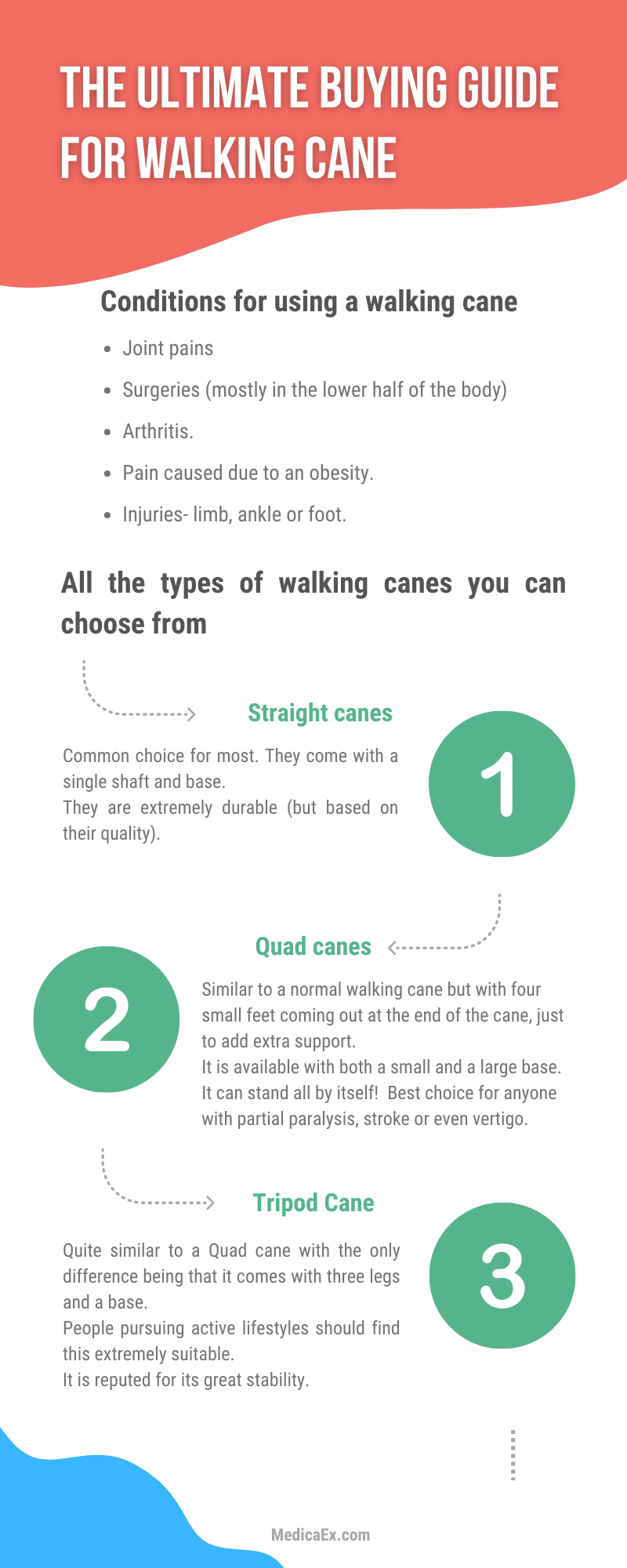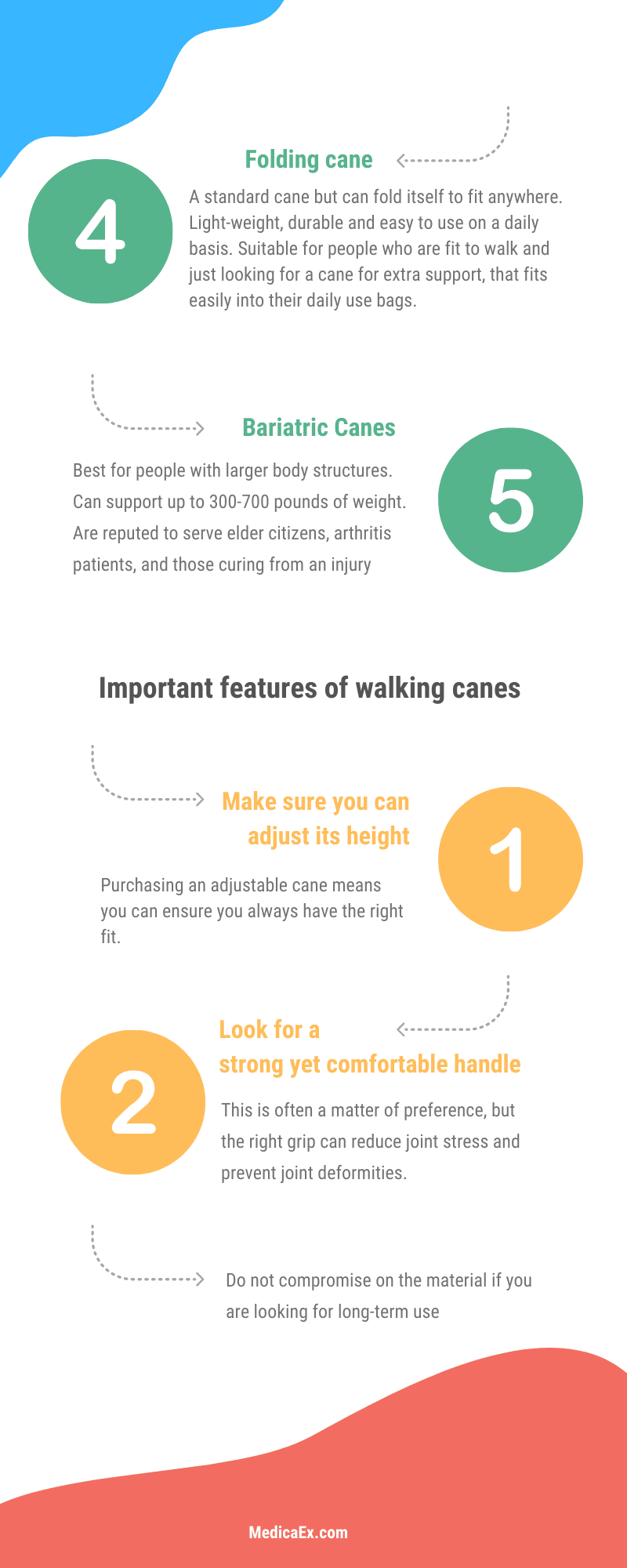Table of Contents
Every year countless aged people in the US suffer from bad falls. One of the leading causes of fatal injuries. The Centre for Disease Control and Prevention has claimed that it is today a necessity to bring about proper precautions and damage control measures to save people from this accidental and severe painful experience of falling.
For the older population who have difficulties in walking, using a walking cane can help them build confidence in their own movement and also the chances of injuries are reduced by almost 70%. Not that walking canes are only for those who are old, it is also a necessity for the injured or the disable. A study held in the USA, a few years back, in 2015, claimed that more than 5 million elder citizens in the country use canes as a support for walking.
While talking about walking canes, choosing the appropriate one is a challenging task. That is, ensuring the best type of cane with the proper height needed, there are various boxes to fill, before you pick one that serves the purpose perfectly.
Also, if necessary, try consulting a professional (a physician or a physical therapist), if you seem unsure about your choice. And to stick to reality- don’t forget to check on what’s available. Through this article, let’s give you a wholesome take on the checklists of buying the best walking cane for you!
Conditions for using a walking cane
With a wide spectrum of reasons, one might find any, to use a walking cane. Some of the common reasons are:
- Joint pains- the most common reason with today’s lifestyle changes.
- Surgeries- mostly in the lower half of the body
- Arthritis
- Pain caused due to an obesity
- Injuries- limb, ankle or foot.
Things to consider before buying a walking cane
- They say, ‘If your left arm is paining, lift up your right arm and watch the pain go away.’ Although it might not sound scientific, it is the rule to use your cane on the unaffected side of your body. That is, if your pain is on the right foot, use the cane with the left-hand putting maximum pressure on the left foot and the supporting cane. Having said that, get a nod from your physician about this and accept if they advise you the other way around.
- The affected leg needs all the rest, so make sure to use your good leg more and insert more pressure on it.
- Move the cane and your bad leg a comfortable distance forward.
- It forms a triangle. Your affected leg and the cane become pillars of strength while your good leg moves forward for growth. Philosophical? Yes, that’s how it works.
- Not too ahead, not too close! Find a rhythm and the perfect distance between your feet and the cane. Hold it mindfully and do not just rush with it. Remember, the cane is to increase your level of comfort and not to win a race!
All the types of walking canes you can choose from:
1. Straight canes
- Common choice for most. They come with a single shaft and base.
- Most people prefer using this, so you can have one in various colours, grip types and materials.
- They are extremely durable (but based on their quality).
- A tip: hold the cane in your hand and try walking with it for a while if possible. This helps you to figure the right kind of grip for you.
2. Quad canes
- Similar to a normal walking cane but with four small feet coming out at the end of the cane, just to add extra support.
- Able to handle more weight than a regular one. Plus, it ensures a more comfortable and stable walk.
- It is available with both a small and a large base.
- It is also a better option for those who have to take stairs, as these canes are a lot better in helping you with that.
- And call it a lottery when you don’t need to find a place to keep it when you sit. It can stand all by itself!
- Best choice for anyone with partial paralysis, stroke or even vertigo.
3. Tripod Cane
- Quite similar to a Quad cane with the only difference being that it comes with three legs and a base.
- People pursuing active lifestyles should find this extremely suitable.
- The design is made such that it perfectly suits outdoor atmosphere and rough road conditions like uneven path, grass or small stones.
- It is reputed for its great stability and steady nature mainly because of the three legs.
4. Folding cane
- A standard cane but can fold itself to fit anywhere.
- This folding system is because of the increased number of joints it has compared to a normal cane.
- It comes with several types of hand grips and colours to choose from
- Suitable for people who are fit to walk and just looking for a cane for extra support, that fits easily into their daily use bags.
- Light-weight, durable and easy to use on a daily basis.
5. Bariatric Canes
- Best for people with larger body structures
- Can support up to 300-700 pounds of weight.
- Are reputed to serve elder citizens, arthritis patients, and those curing from an injury
Important features of walking canes
Expecting to find the right walking stick and losing sleep over such a silly problem? Not anymore. Just keep in mind these simple things and you are ready for the bargain!
- Make sure you can adjust its height: Purchasing an adjustable cane means you can ensure you always have the right fit. Plus, you don’t have to deal with cutting a cane to the right size.
- Look for a strong yet comfortable handle: This is often a matter of preference, but the right grip can reduce joint stress and prevent joint deformities. Grips come in different shapes and materials, and your physician or physical therapist can help you decide which one to go for.
- Do not compromise on the material if you are looking for long-term use: With loud and clear words, make it absolutely clear NOT to compromise with the quality of the material used for the cane. If you want to use it for a long term and not want it to break or rust itself, spend a few more bucks on something durable.
- What more do you get: You might need an extra handle attached to the walking cane just to help you get up? Or you might be imagining one with a complementary seat that serves the need to take breaks? Well, that’s what you get. There are products with these are many more such needs of the user, which are both affordable and user-friendly. Don’t compromise on your requirements and search for a cane that you would genuinely feel like using.
Infographics









